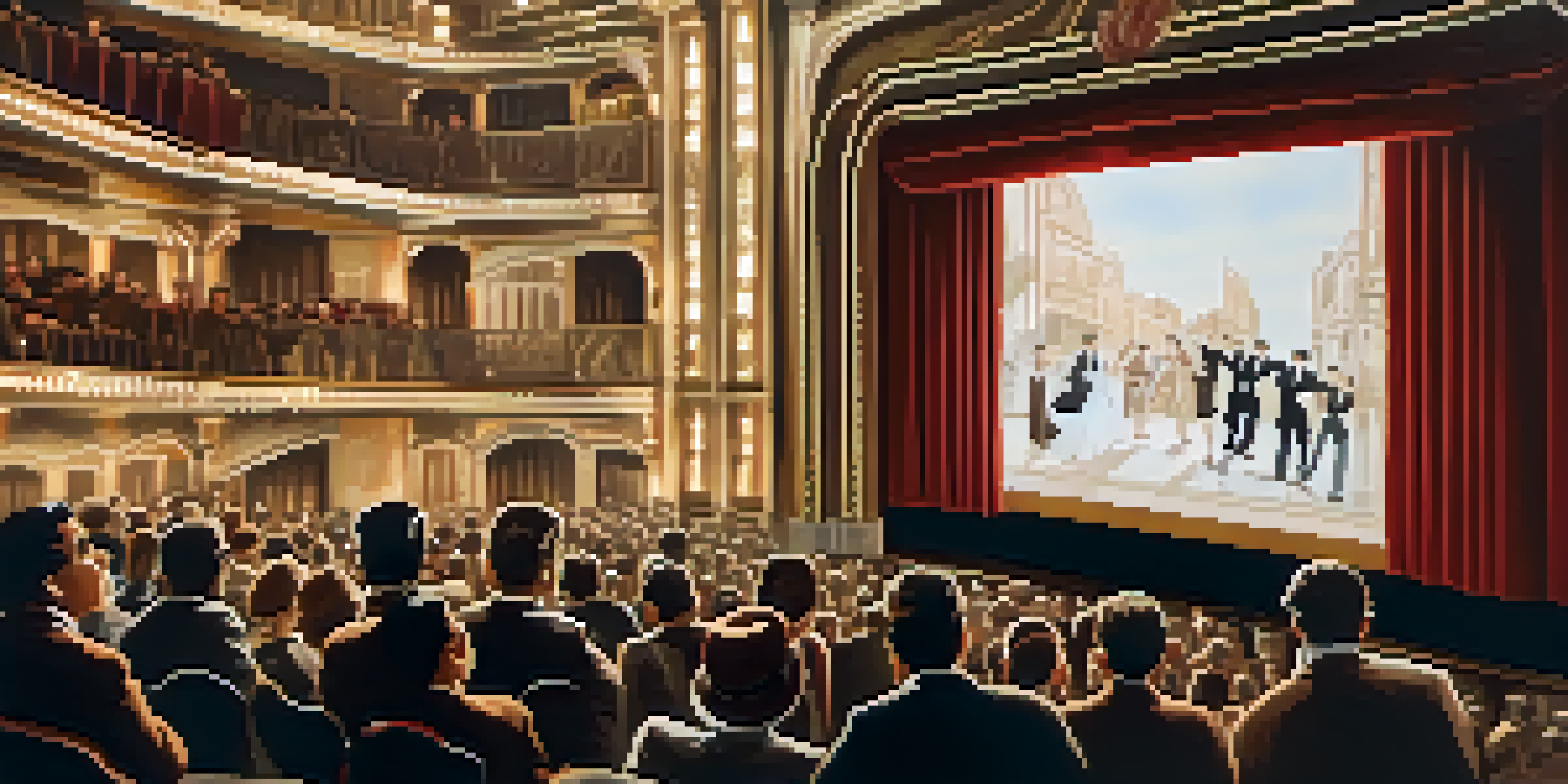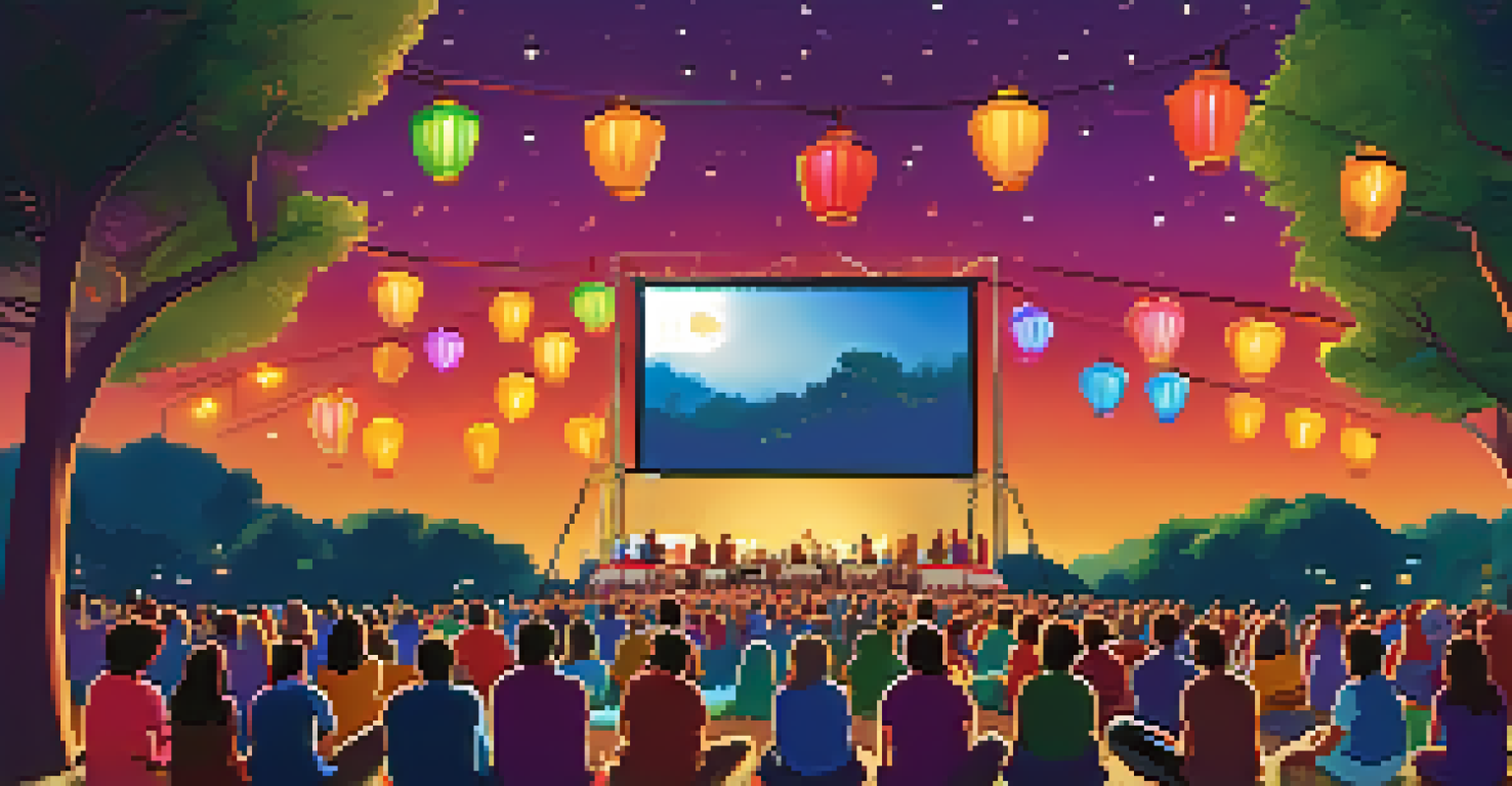The Evolution of Spanish Cinema: From Silent Films to Today

The Birth of Spanish Cinema: Silent Beginnings
Spanish cinema began in the late 19th century, with the first film shown in 1896. These early films were short, silent, and often featured everyday life or comedic vignettes. Pioneers like Fructuós Gelabert and the Lumière brothers captured the public's imagination, laying the groundwork for cinematic storytelling in Spain.
Cinema is a mirror by which we often see ourselves.
The silent era in Spain was marked by a mix of local productions and the influence of international films. As audiences flocked to theaters, the demand for content grew, leading to the establishment of more studios and filmmakers. This period was crucial for developing a unique Spanish identity in cinema, which would evolve over the decades.
Despite the limitations of silent films, directors found creative ways to engage viewers through expressive performances and innovative storytelling. The foundation they built set the stage for future advancements in Spanish cinema, paving the way for the introduction of sound in films.
The Introduction of Sound: A New Era
The advent of sound in the late 1920s transformed the film landscape worldwide, and Spain was no exception. The first Spanish sound film, 'Don Juan' (1934), captivated audiences with its musical elements and dialogue. This innovation allowed filmmakers to tell deeper stories and connect with viewers on a more personal level.

As sound technology improved, Spanish cinema began to flourish, leading to a boom in musical and comedic films. This era saw the emergence of iconic stars like Antonio Molina and Concha Piquer, who became household names. Their performances resonated with the public, making cinema a vital part of Spanish culture.
Evolution of Spanish Cinema
Spanish cinema has transformed from silent short films in the late 19th century to a dynamic industry embracing sound, diverse stories, and innovative technologies.
However, the introduction of sound also brought challenges, particularly during the Spanish Civil War. Filmmakers faced censorship and restrictions, which influenced the themes and styles of films produced during this tumultuous period. Despite these obstacles, the creativity of Spanish filmmakers shone through, as they adapted to the changing landscape.
The Golden Age: The 1950s and 60s
The 1950s and 60s are often considered the Golden Age of Spanish cinema, marked by a surge of artistic expression and international recognition. Filmmakers like Luis Buñuel and Juan Antonio Bardem pushed boundaries, exploring complex themes that resonated with audiences both at home and abroad. Their bold storytelling established Spain as a significant player in the global film industry.
The power of cinema is that it can show us realities we can’t or don’t want to see.
During this period, the Spanish film industry produced a variety of genres, including dramas, comedies, and horror films. The blend of traditional Spanish culture with modern cinematic techniques created a unique style that captivated viewers. This era also saw the rise of the 'star system,' with actors becoming cultural icons.
However, the political climate under Franco's regime posed challenges to filmmakers. Censorship laws restricted creative expression, forcing directors to navigate a complex landscape. Despite these hurdles, many filmmakers used allegory and symbolism to comment on societal issues, leaving a lasting impact on Spanish cinema.
The Transition: The 1970s and 80s
The 1970s marked a period of transition for Spanish cinema, as the country moved towards democracy after Franco's death in 1975. This newfound freedom allowed filmmakers to explore previously taboo subjects, leading to a creative renaissance. Directors like Pedro Almodóvar emerged, bringing a fresh voice to Spanish film with their unique perspectives and bold narratives.
This era also saw the rise of the 'Spanish New Wave,' characterized by innovative storytelling and a focus on social issues. Filmmakers began to experiment with different cinematic styles, mixing genres and breaking traditional storytelling norms. The shift in tone reflected the societal changes happening in Spain, making cinema a mirror of contemporary life.
Golden Age and Political Challenges
The 1950s and 60s marked a Golden Age for Spanish cinema, where filmmakers navigated censorship while producing influential works that resonated globally.
As Spanish cinema gained international attention, filmmakers began to collaborate with foreign talent, further enriching the film landscape. The resulting cross-pollination of ideas and styles helped to elevate Spanish cinema on the global stage, paving the way for future generations of filmmakers.
The Rise of Independent Cinema: The 1990s
The 1990s saw the emergence of independent cinema in Spain, with filmmakers seeking to tell diverse stories outside the constraints of mainstream production. This movement was fueled by the success of films like 'Jamón, Jamón' and 'The Flower of My Secret,' which showcased unique perspectives on Spanish life. Independent cinema became a platform for exploring complex themes, often with a sense of humor and authenticity.
During this decade, directors such as Alejandro Amenábar and Isabel Coixet gained recognition for their innovative storytelling. Their films often tackled issues like identity, love, and loss, resonating with audiences both domestically and internationally. This era proved that Spanish cinema could thrive outside the traditional studio system.
The rise of independent films also coincided with a growing interest in Spanish cinema globally. Festivals like the San Sebastián International Film Festival began to spotlight Spanish talent, providing a platform for emerging filmmakers to showcase their work. This increased visibility helped to solidify Spain's place in the international film community.
Modern Spanish Cinema: The 2000s to Today
As we entered the 21st century, Spanish cinema continued to evolve, with filmmakers embracing new technologies and storytelling methods. The rise of digital filmmaking opened doors for a new generation of directors, allowing for greater creativity and experimentation. Movies like 'Pan's Labyrinth' and 'The Sea Inside' showcased the depth and diversity of contemporary Spanish storytelling.
In recent years, Spanish cinema has gained widespread acclaim, with films winning prestigious awards at international festivals. Directors such as Almodóvar, Amenábar, and Carlos Saura have received recognition for their contributions to the art form, further elevating Spain's cinematic reputation. This success has also led to increased collaboration with Hollywood and other global markets.
Future Trends in Filmmaking
The future of Spanish cinema looks promising, with an emphasis on diverse voices and technological innovations that enhance storytelling.
Moreover, the streaming revolution has allowed Spanish films to reach audiences worldwide. Platforms like Netflix and Amazon Prime have invested in Spanish content, showcasing a variety of genres and styles. As a result, Spanish cinema is not only thriving domestically but is also making its mark on the global stage, enriching the cultural landscape for viewers everywhere.
The Future of Spanish Cinema: Trends and Innovations
Looking ahead, the future of Spanish cinema appears bright, with a growing emphasis on diverse voices and stories. Filmmakers are increasingly focusing on representation, exploring themes of gender, race, and sexuality. This shift reflects a broader trend in the industry, as audiences seek authentic narratives that resonate with their experiences.
Technological advancements are also shaping the future of Spanish cinema. Virtual reality and interactive storytelling are beginning to make waves, offering new ways for audiences to engage with films. These innovations provide exciting opportunities for filmmakers to push boundaries and create immersive experiences that captivate viewers.

As Spanish cinema continues to evolve, it will undoubtedly face challenges, including competition from global markets and changing audience preferences. However, the resilience and creativity of Spanish filmmakers suggest that they will adapt and thrive, ensuring that Spanish cinema remains a vital and dynamic part of the global film landscape.